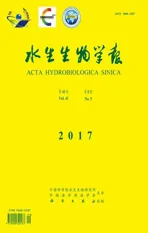TAXONOMIC STUDIES OF THE CENTRIC DIATOM FROM THE LAKE CHANGHAI, JIUZHAIGOU VALLEY, CHINA, INCLUDING THE DESCRIPTION OF A NEW SPECIES
2017-09-12XUJiXiongYOUQingMinKOCIOLEKPatrickandWANGQuanXi
XU Ji-Xiong, YOU Qing-Min, KOCIOLEK J. Patrickand WANG Quan-Xi
(1. College of Life and Environmental Sciences, Shanghai Normal University, Shanghai 200234, China; 2. Museum of Natural History and Department of Ecology and Evolutionary Biology, University of Colorado, Boulder, CO 80309, USA)
TAXONOMIC STUDIES OF THE CENTRIC DIATOM FROM THE LAKE CHANGHAI, JIUZHAIGOU VALLEY, CHINA, INCLUDING THE DESCRIPTION OF A NEW SPECIES
XU Ji-Xiong1, YOU Qing-Min1, KOCIOLEK J. Patrick2and WANG Quan-Xi1
(1. College of Life and Environmental Sciences, Shanghai Normal University, Shanghai 200234, China; 2. Museum of Natural History and Department of Ecology and Evolutionary Biology, University of Colorado, Boulder, CO 80309, USA)
In this study, four centric diatom are reported from Lake Changhai in Jiuzhaigou Valley, Sichuan Province, China. One new Cyclotella species: Cyclotella changhai sp. nov., one newly-recorded species from China: Cyclotella cretica, and two rare reported centric diatoms: Cyclotella distinguenda and Lindavia radiosa. The morphology of these four species is documented by light and scanning electron micrographs and compared with similar species. Cyclotella changhai sp. nov. is similar to C. comensis Grunow, C. pseudocomensis Scheffler and C. costei Druart & Straub, but is distinguished from them by the structure of the central area in the valve: nearly flat central area with irregular depressions.
Centric diatom; Cyclotella; Lindavia; Jiuzhaigou Valley; China; New species; Taxonomy
Cyclotella (Kützing) Brébisson (1838) is a large, complex genus first described by Kützing that was elevated from the level of subgenus and established as a genus by Brébisson[1,2]. Krammer and Lange-Bertalot (1991) included 43 species and subspecies in the genus Cyclotella in their freshwater flora from central Europe[3]. Lowe, Serieyssol, and Theriot & Serieyssol documented the wide variety of morphologies assigned to the genus Cyclotella sensu lato[4—6]. Within the last 15 years, Some Cyclotella species have been transferred to new genera, including Puncticulata Håkannson (2002) and Discostella Houk & Klee (2004)[7,8]. Nakov et al. made the formal transfer of 90 species from Cyclotella, Handmannia Peragallo (1913), Pliocenicus Round & Håkansson (1992) and Puncticulata into Lindavia (Schütt)[9—11].
Lake Changhai (32°44′N, 104°06′E), locates in the middle of Zechawa Gully in Jiuzhaigou Valley, Sichuan Province, China, which is the largest (0.93 km2) and the deepest (the maximum depth nearly 100 m, mean depth of 44.57 m) lake in Jiuzhaigou Valley. The altitude of Lake Changhai is 3060 m. Water for the lake comes mainly from rainfall, streams, melted snow and groundwater, while the water discharges mainly underground to another gully. Lake Changhai was formed by a collapse of nearby lithology, creating a damming of the lake[12].
In order to gather information on the plankton assemblages of Lake Changhai, 20 samples were collected, and were dominated by three Cyclotella species and one Lindavia species. One of the Cyclotella species appears to be new to science, and is described as a new taxon: Cyclotella changhai.
1 Material and methods
Samples were collected from the Lake Changhai in July 2014. Surface samples (0.5 m) of phytoplankton were collected using Van Dorn bottles (2 L volume), from the northern region (upstream) to southern region of the lake. The samples were transferred to the laboratory for immediate analysis. Sec-chi disk depth, as well as temperature, pH, conductivity and dissolved oxygen were measured in situ with YSI Pro Plus (YSI instrument, Ohio, USA).

Fig. 1 Map of Lake Changhai, Jiuzhaigou Valley, Sichuan Province, China
For diatom identification, samples were treated with concentrated nitric acid using the Microwave Accelerated Reaction System (Model MARS, CEM Corporation). The digestion followed a pre-programmed digestion scheme (temperature: 180℃, ramp: 15min hold: 15min). After digestion, samples were alternatively centrifuged (five minutes at 3500 rpm) and washed with distilled water (approximately five times) until the pH of the sample was approximately neutral. The cleaned material was kept in 95% C2H5OH. LM observations were made with an OLYMPUS BX53 equipped with OLYMPUS DP80 camera system. SEM examinations were conducted on a JEOL JSM-6380LV. Diatom images were complied with the software Photoshop CS6. Samples and mounted slides are kept in the Herbarium of the Biology Department of Shanghai Normal University (SHTU).
2 Results and discussion
The phytoplankton samples from Lake Changhai were dominated by a previously undescribed Cyclotella species: Cyclotella changhai. The relative abundance of C. changhai reached to 69.59%—86.00%. Diatoms observed in these phytoplankton samples included other members of the Thalassiosirales, specifically Cyclotella cretica, Cyclotella distinguenda and Lindavia radiosa.
2.1 Cyclotella changhai J.-X. Xu & J.P. Kociolek, sp. nov. (Figs. 2—23)
Description Valves cylindrical circular, 7—11 μm in diameter, solitary or in chains. Striation fine, 20—24 striae in 10 μm, often of unequal lengths. Marginal fultoportulae situated on every, 2—4 (5) costae. Costae slightly or not depressed, external opening of marginal fultoportulae is simple, internal opening with two satellite pores. One rimoportula situated at the end of striae near the marginal/central area limit, with a distinct external opening on a costa, internally with a sessile labium situated near the valve face margin and having a relatively short oblique slit. Central area nearly flat with irregular depressions not penetrating the cell wall and takes about 1/2—3/5 of the valve diameter. Small granules situated on some valves. Cingulum composed of several copulae. A single fultoportula situated in the central area, internally a short central tube surrounded by two satellite pores. Striae composed of two parallel rows of areolae with smaller areolae between them.
Type Jiuzhaigou Valley, Sichuan Province, China (holotype SHTU!, slide JZG-CH201407-01, illustrated in Fig. 3).
Etymology This species is named after Changhai Lake, the only locality from which it is known.
Distribution and ecology Lake Changhai, Jiuzhaigou Valley, Sichuang Province, China. Lake Changhai is an oligotrophic, alpine lake. The lake is alkaline (pH 8.27—8.76). The temperature ranged from 9.0℃ to 14.9℃.
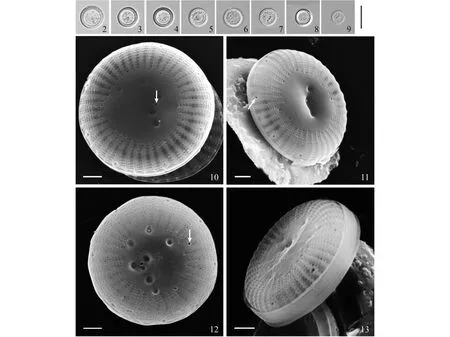
Fig. 2—13 Cyclotella changhai, sp. nov. 2—9. LM. Valve views showing size diminution series. Figure 3 is of the holotype. Scale bars=10 μm for all LM figures. 10—13. SEM. 10. External view of whole valve showing opening of central fultoportula (arrow). 11. Oblique view of frustule showing opening of mantle fultoportulae (arrow). 12. External opening of rimoportula (arrow). 13. Oblique view showing a flat external valve and irregular depressions in the central area. The girdle band is smooth, composed of several copulae. Scale bars=1 μm for all SEM figures
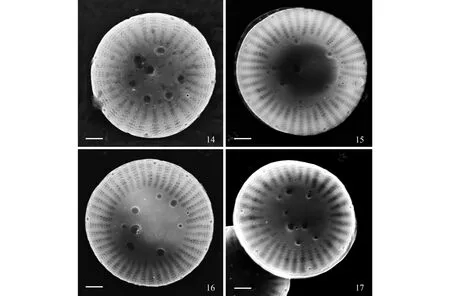
Fig. 14—17 Cyclotella changhai, sp. nov. SEM. Different external view of Cyclotella changhai. Scale bars=1 μm for all SEM figures
Observations Our species is most similar to Cyclotella comensis (Grunow 1882: 213), C. pseudocomensis (Scheffler 1994: 217) and C. costei (Druart & Straub 1988: 22), these four species are very similar morphologically especially internally[13—15]. They differed in the valve exterior of the central area. Cyclotella costei has a nearly flat central area and no depressions are observed while C. pseudocomensis has a distinctly undulate central area[14,15]. Cyclotellacomensis has a lobate-shaped central area, with radially positioned larger bulges or bumps in the center[16]. Cyclotella changhai differs from these three species by having a flat central area, with some irregular depressions in the central area. C. cretica (John & Economou-Amilli 1990), C. delicatula (Hustedt 1952), C. kuetzingiana (Håkansson 1990) and C. wuethrichiana (Druart & Straub 1988) also have different moprohological features as compared with C. changhai (Tab. 1)[17,18].
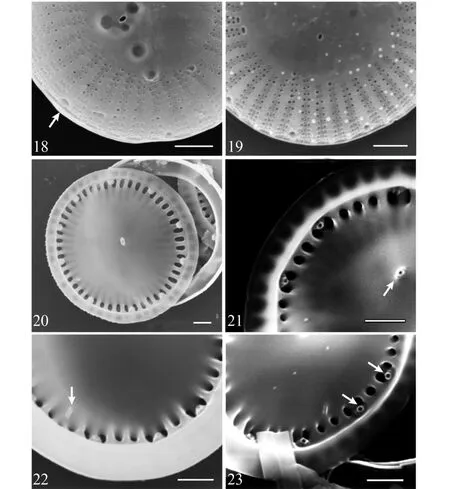
Fig. 18—23 Cyclotella changhai, sp. nov. SEM. 18. Detailed view of marginal area showing mantle fultoportulae (arrow). 19. Detailed view of marginal area showing striae are composed of two parallel rows of areolae with smaller areolae between them. 20. Internal view of valve. 21. Detailed view of central fultoportula with two satellite pores (arrow). 22. A single rimoportula situated in front of or below a costa (it is on the valve face) (arrow). 23. Detailed view of mantle fultoportulae with two satellite pores (arrow). Scale bars=1 μm for all SEM figures
2.2 New Species Record from China Cyclotella cretica John & Economou-Amilli, (Figs. 24—37)
Description Valves cylindrical, circular, 8—14 μm in diameter, solitary or in chains. Striation fine, 18—22 striae in 10 μm, often of unequal lengths. The marginal fultoportulae situated on every, slightly depressed, 3—5 (7, see Fig 32) costae, externally with a simple opening, internally with two satellite pores. A single rimoportula situated at or below a costa, with a distinct external opening. Internally, rimoportula is a sessile labium situated near the valve face margin. The central area is nearly flat with mostly three, rarely 1—5, fultoportula and internally the fultoportulae have a short central tube surrounded by two satellite pores. Small granules situated on some valves. The striae are composed of 1—2 areolae near the center valve and 4 areolae toward the margin.
Distribution and ecology Lake Changhai,Jiuzhaigou Valley, Sichuan Province, China. Lake Kournas on island of Crete, Greece. Lake Changhai is an oligotrophic, alpine lake. The relative abundance of Cyclotella cretica ranged from 2.09% to 8.11%.
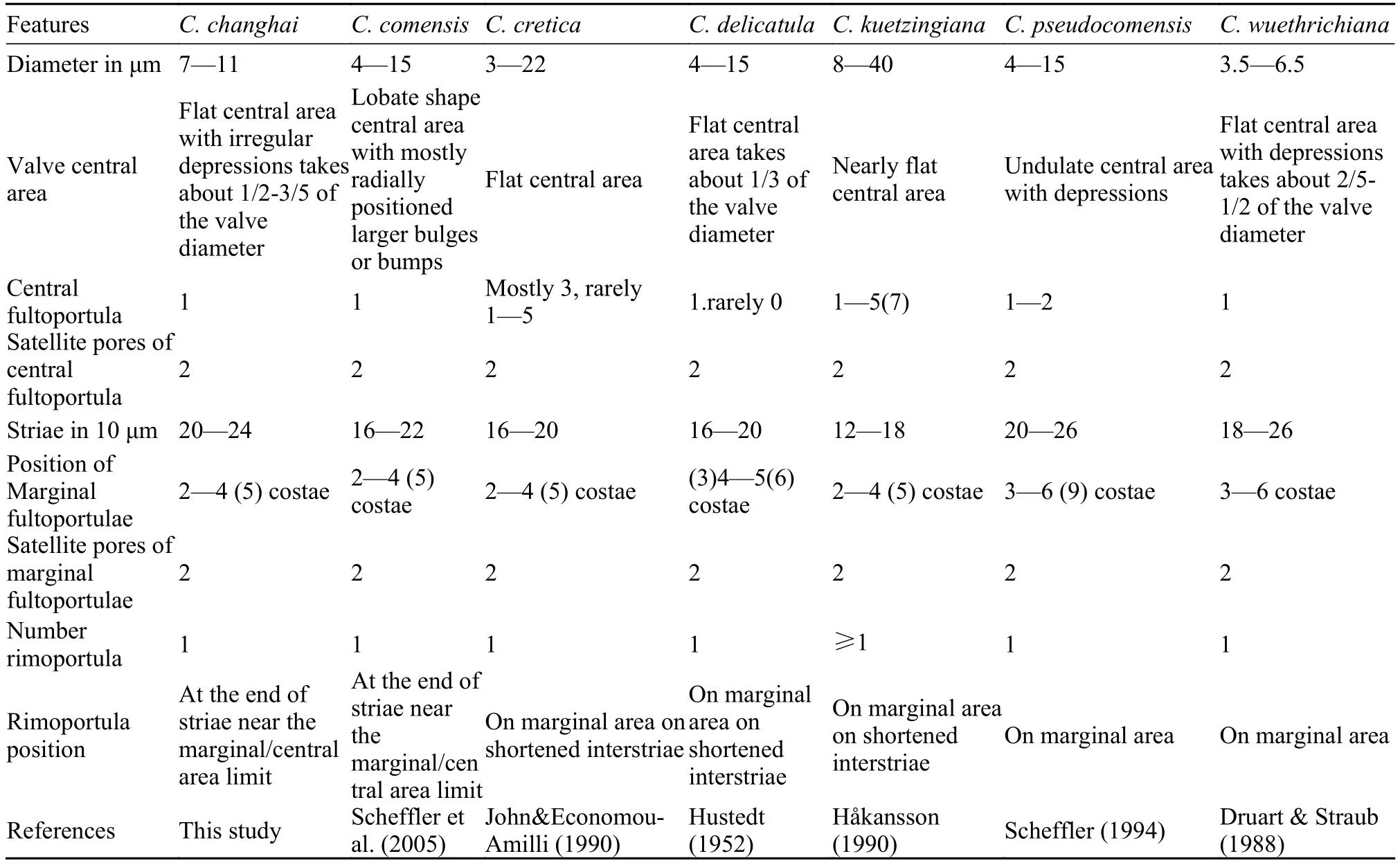
Tab. 1 Comparison of Cyclotella changhai sp. nov with similar species based on morphological key characters
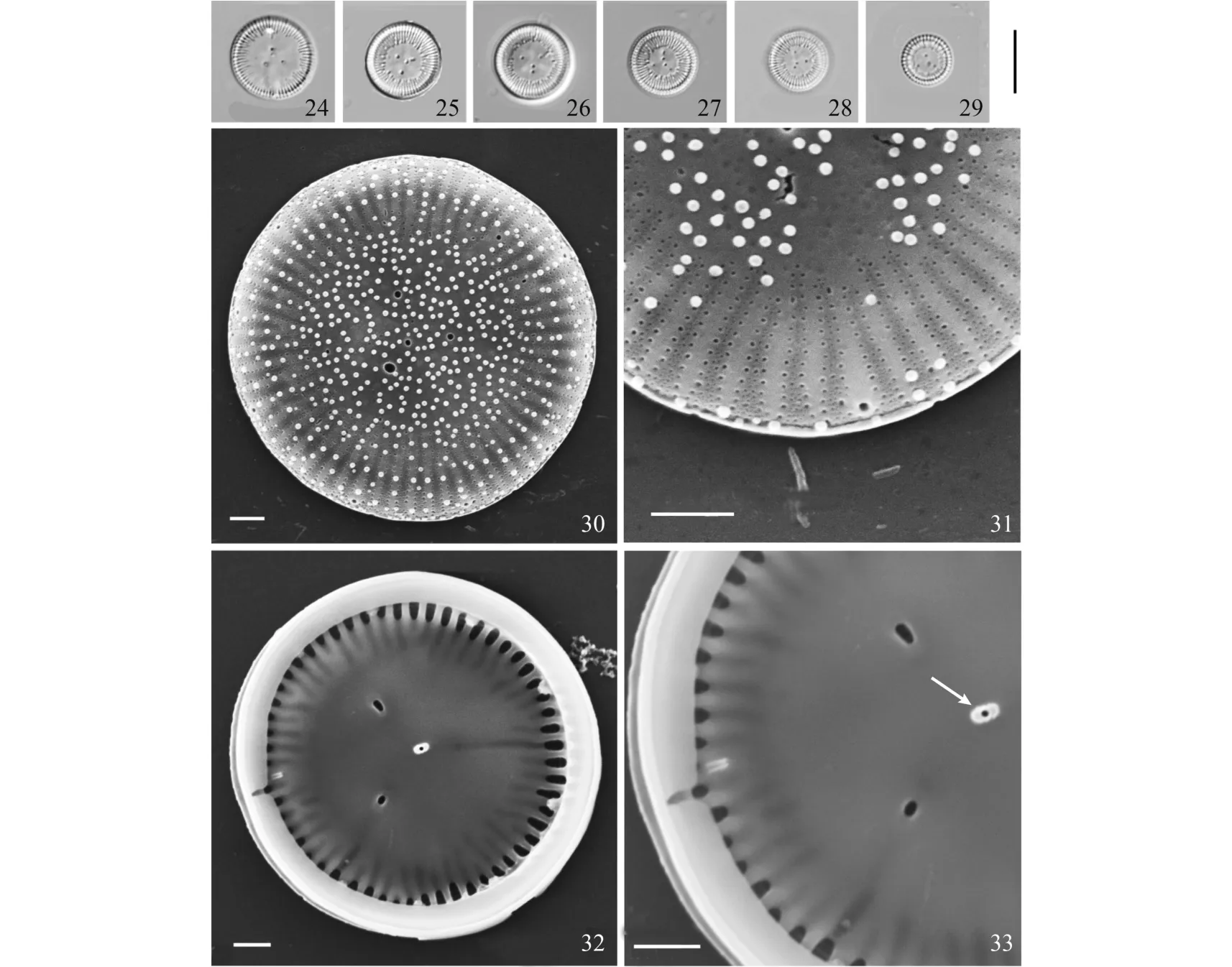
Fig. 24—33 Cyclotella cretica. 24—29. LM. Valve views showing size diminution series. Scale bars=10 μm for all LM figures. 30—33. SEM. 30. External view of whole valve with many granules. 31. Detailed view of marginal area showing striae are composed of 1—2 areolae near the center and 4 areolae toward the margin. 32. Internal view of valve. 33. Detailed view of central fultoportula with two satellite pores (arrow) and one rimoportula situated at the end of a stria in the marginal area. Scale bars=1 μm for all SEM figures
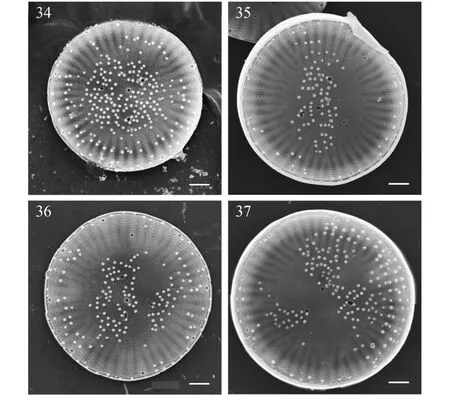
Fig. 34—37 Cyclotella cretica SEM. Different external view of Cyclotella cretica. Scale bars=1 μm for all SEM figures
Observations The specimens in our samples, have marginal fultoportulae situated between 3—5 (6) costae, that are slightly depressed. John & Economou-Amilli found 2—5 costae between each marginal fultoportula[17,19]. SEM observations show the distance between striae is greater in our specimens than reported in the original description of C. cretica (John & Economou-Amilli 1990). LM observations show the central fultoportula organized in the shape of a triangle, while the central fultoportulae are closer together in the population from Greece than in our specimens. Our species is most similar to C. comensis morphotype minima (Scheffler & Morabito 2003) and C. ocellata (Genkal & Popovskaya 2008), since they also have granules on the valve face[20,21]. While the two species have obvious differences compared with C. cretica. C. comensis morphotype minima, for example, is only 2.6—6.7 μm in diameter. The cells vary from roll - to drum-shaped structure and valve face is plane to slightly concave with small granules. One fultoportula with 0—2 satellite pores is situated near the central part of the valve face. C. ocellata has a 3—6 larger, ± concentrically arranged granules, with distinct circular depressions between them[6,15].
2.3 Taxa previously reported from China Cyclotella distinguenda Hustedt (Figs. 38—49)
Description Valves cylindrical, circular, 10—24 μm in diameter, central area of the valve face occupies about 1/2 of the valve diameter, cells mostly solitary. Striae of equal lengths, 11—15 in 10 μm. The marginal fultoportulae situated between the 2—4 (5), slightly depressed, costae, externally with a simple opening internally bordered by three satellite pores. At least one rimoportula situated within the ring of the marginal fultoportulae, with a distinct external opening on a costa, internally with a sessile labium situated near the valve face margin, and having a relatively short oblique orientation. The central part of the valve is tangentially undulate, without central fultoportulae. The striae are composed of 2—3 areolae near the center of the valve and 4—5 areolae toward the margin.
Distribution and ecology Lake Changhai, Jiuzhaigou Valley, Sichuan Province, China. The relative abundance of Cyclotella distinguenda ranged from 0.62% to 5.83%. This taxon is of broad occurrence in the plankton of lakes and large rivers
Observations This species has a valve organization similar to C. gamma (Sovereign 1963: 151), however, the striae of C. distinguenda are narrow near the central area, while the striae of C. gamma are broad[22]. In addition, two shadow lines are visible in C. gamma, while only one is visible in C. distinguenda (Lowe & Manoylov 2011)[23].
2.4 Lindavia radiosa (Grunow) De Toni & Forti (Figs. 50—61)
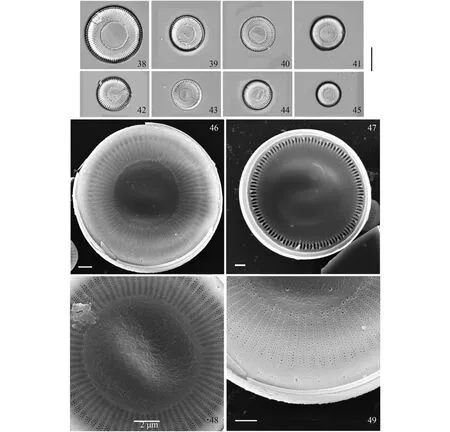
Fig. 38—49 Cyclotella distinguenda. 38—45. LM. Valve views showing size diminution series. Scale bars=10 μm for all LM figures. 46—49. SEM. 46, 48. External view of valve, 47. Internal view of valve. 49. Detailed view of mantle fultoportulae and striae are composed of 2—3 areolae near the center valve and 4—5 areolae toward the margin. Scale bars=2 μm for all SEM figures
Description Valves cylindrical circular, 10—21 μm in diameter, mostly solitary, central area of the valve face occupying about 1/2 of the valve diameter. Striae of equal lengths, 16—18 in 10 μm. Areolae form radial rows in the margin and slightly depressed towards the central area. The central fulto-portulae situated in the central area, and internally a short central tube surrounded by three satellite pores, arranged in ring. The marginal fultoportulae situated on each thickened costae, externally with a simple opening, internally by two satellite pores. At least one rimoportula situated in marginal area. The marginal striae are composed of 2—3 areolae near the valve center and 3 areolae toward the margin.
Distribution and ecology Lake Changhai, Jiuzhaigou Valley, Sichuan Province, China. The relative abundance of Lindavia radiosa ranged from 3.72% to 13.98%. This taxon is of broad occurrence in the pelagic zone of the plankton from oligotrophic to eutrophic lakes.
Observations Lindavia radiosa was originally described as Cyclotella comta var. radiosa Grunow in Van Heurck (1882), and then Lemmermann recognized it as a separate species, Cyclotella radiosa (Grunow) Lemmermann (Tanaka 2007). Håkansson transferred it to genus Punticulata[24—26]. The genus Puncticulata had been transferred to Lindavia recently, Nakov et al. made the formal transfer to Lindavia[27].

Fig. 50—61 Lindavia radiosa. 50—57. LM. Valve views showing size diminution series. Scale bars=10 μm for all LM figures. 58—61. SEM. 58, 60. External view of whole valve. 59. Oblique view showing marginal fultoportulae situated on each thickened costae (arrow). 61. Internal view of valve showing central fultoportulae situated in the central area, and internally a short central tube surrounded by three satellite pores, arranged in ring (arrow). Scale bars=1 μm for all SEM figures
These three genera, Cyclotella, Punticulata and Lidavia are all have differential ornamentation between the central and marginal areas. While what makes Lindavia different from other two genera is that one or more rimoportulae on the valve face, therimoportulae are not positioned alongside the marginal fultoportulae; furthermore, the central area of Cyclotella is always flat to tangentially undulate, and the central area of Punticulata is variable: with both areolae and fultoportulae, or areolae only, or fultoportulae only, when present fultoportulae, it possess three satellite pores[26,27].
Moreover, Lindavia radiosa closely resembles L. praetermissa (Lund) Nakov, et al. (2015: 257), but it can be distinguished by the absence of approximately radial rows[27].
3 Discussion
Cyclotella sensu lato taxa are a key group of diatoms that are frequently dominant members of phytoplankton communities in low-to-moderate productivity lakes[28]. Lake Changhai is an alpine oligotrophic lake, with almost no disturbance by human activity. Zhou et al., in their survey of the phytoplankton in lakes from Jiuzhaigou National Park, reported that only the genus Cyclotella was dominant in Lake Changhai, but they did not identify the species present[29]. Cyclotella changhai, C. cretica, C. distinguenda and Lindavia radiosa were observed together with other 27 genera, 51 species, and together these four diatoms reached nearly 90%. Previously, C. cretica was only found in the plankton of Lake Kournas on island of Crete, Greece[17,30]. Cyclotella distinguenda is a taxon broad occurrence in the plankton of lakes and large rivers and is known to prefer alkaline environments[3,23,31]. Lindavia radiosa is reported as a cosmopolitan taxon, reported from the pelagic zone of the plankton from oligotrophic to eutrophic lakes[3].
As noted previously, Cyclotella changhai described herein is morphologically similar to C. comensis, C. costei and C. pseudocomensis. Kisnich et al. (2014), using molecular and molecular data on (no-type) populations of species reported as these three taxa, have suggested they may represent a single taxon[32]. Currently, based on published morphological data, C. changhai can be separated from these three other taxa (Tab. 1). Future research with molecular data for the Chinese taxon can test whether it an also be distinguished from the European populations.
Acknowledgments:
We appreciate logistic supports provided by several park staff.
[1]Brébisson A. Considération sur les Diatomées et essai d’une classification des genres et des espèces appurtenantácette famille [M]. Falaise, 1838, 1—22
[2]Kützing F T. Synopsis Diatomearum oder Versuch einer systematischen Zusammenstellung der Diatomeen [M]. Linnaea, 1833, 529—629
[3]Krammer K, Lange-Bertalot H. Bacillariophyceae, 3. Teli: Centrales, Fragilariaceae, Eunotiaceae.-In: Ettl H., Gerloff J, Heynig H. & Mollenhauer [M]. Gustav Fischer Verlag, Stuttgart, Jena, 1991, 2/3, 40—43
[4]Lowe R L. Comparative ultrastructure of the valve of some Cyclotella species (Bacillariophyceae) [J]. Journal of Phycology, 1975, 11: 415—424
[5]Serieyssol K K. Cyclotella Species of Late Miocene Age from St. Bauzile, France. In: Ross, R (Eds.), Proceedings of the 6thInternational Diatom Symposium [M]. Philadelphia, USA. Koeltz, Königstein. 1982, 197—211
[6]Theriot, Serieyssol. Phylogenetic systematics as a guide to understanding feature and potential morphological characters of centric diatom family Thalassiosiraceae [J]. Diatom Research, 1994, 9(2): 429—450
[7]Håkansson H. A compilation and evaluation of species in the general Stephanodiscus, Cyclosteohanos and Cyclotella with a new genus in the family Stephanodiscaceae [J]. Diatom Research, 2002, 17(1): 1—139
[8]Houk V, Klee R. The stelligeroid taxa of the genus Cyclotella (Kützing) BRÉBISSON (Bacillariophyceae) and their transfer into the new genus Discostella gen. nov [J]. Diatom Research, 2004, 19(2): 204—228
[9]Nakov T, Guillory W X, Julius M L, et al. Towards a phylogenetic classification of species belonging to the diatom genus Cyclotella (Bacillariophyceae): Transfer of species formerly placed in Puncticulata, Handmannia, Pliocaenicus and Cyclotella to the genus Lindavia [J]. Phytotaxa, 2015, 217(3): 249—264
[10]Handmann R. Die Diatomeenflora des Almseegebiets [M]. Mikrologischen vereins Linz, 1913, 4—30
[11]Round F E, Håkansson H. Cyclotelloid species from a diatomite in the Harz mountains, Germany, including Pliocaenicus gen. nov [J]. Diatom Research, 1992, 7: 109—125
[12]Zhou X L. Instead of glacier damming lake, Changhai Lake in Jiuzhaigou Resort Area, Sichuan Province, China should beregarded as a damming lake caused by collapse [J]. Geological Bulletin of China, 2009, 28(7): 970—978
[13]Håkansson H. A comparison of Cyclotella krammeri sp. nov. and C. schumannii Håkansson stat. nov. with similar species [J]. Diatom Research, 1990, 5(2): 261—271
[14]Scheffler W. Cyclotella pseudocomensis nov. sp. (Bacillariophycaea) aus Norddeutschen Seen [J]. Diatom Research, 1994, 9(2): 355—369
[15]Druart J C, Straub F. Description de deux nouvelles Cyclotelles (Bacillariophyceae) de milieualcalins et eutrophes: Cyclotella costeinov. sp. et Cyclotella wuethrichiana nov.sp. [J]. Schweiz. Z. Hydrol, 1988, 50(2): 182—188
[16]Schefffler W, Nicklisch A, Schönfelder I. Beiträge zur Mor-phologie Öklogie und Ontogenie der planktischen Diatomee Cyclotella comensis Grunow. Untersuchungen an historischem und rezentem Material [J]. Diatom Research, 2005, 20(1): 171—200
[17]John J, Economou-Amilli A. Cyclotella cretica, a new species of diatom from the island of Crete, Greece [J]. Diatom Research, 1990, 5(1): 43—50
[18]Hustedt F. Neue und wenig bekannte Diatomeen.Ⅳ. - Botaniska Notiser. Häfte 4 [M]. Lund, 1952, 366—410
[19]Håkansson H, Carter J R. An interpretation of Hustedt’s terms “Schattenlinie”, “Perlenreihe” and “Hocker” using specimens of the Cyclotella radiosa-complex, C. distinguenda Hust., and C. cyclopuncta nov. sp [J]. Journal of the Iowa Academy of Science, 1990, 97(4): 153—156
[20]Scheffler W, Morabito G. Topical observations on centric diatoms (Bacillariophyceae, Centrales) of Lake Como (N. Italy) [J]. Journal of Limnology, 2003, 62: 47—60
[21]Genkal S I, Popovskaya G I. Morphological variability of Cyclotella ocellata from lake Khubsugul (Mongolia) [J]. Diatom Research, 2008, 23: 75—91
[22]Sovereign H E. New and rare diatoms from Oregon and Washington [J]. Proceedings of the California Academy of Sciences, 1963, 31(14): 349—368
[23]Lowe R, Manoylov K. 2011. Cyclotella distinguenda. In Diatoms of the United States. Retrieved October 26, 2015, http://westerndiatoms.colorado.edu/taxa/species/cyclotella distinguenda
[24]Van Heurck H. Synopsis des Diatomées de Belgique. Atlas. Ducaju & Cie. [M]. Anvers. 1880, 1—25
[25]Lemmermann F. Beiträge zur Kenntnis der Planktonalgen [M]. Berichte der Deutschen Botanischen Gesellschaft, 1990, 24—32
[26]Tanaka H. Taxonomic studies of the genera Cyclotella (Kützing) Brébisson, Discostella Houket Klee and Puncticulata Håkansson in the family Stephanodiscaceae Glezer et Makarova (Bacillariophyta) in Japan [J]. Bibliotheca Diatomologica, 2007, 53: 1—205
[27]Bahls L. 2015. Lindavia praetermissa. In Diatoms of the United States. Retrieved October 26, 2015, http://westerndiatoms.colorado.edu/taxa/species/lindavia_praetermissa
[28]Saros J E, Anderson N J. The ecology of the planktonic diatom Cyclotella and its implications for global environmental change studies [J]. Biological Reviews, 2014, 90(2): 522—541
[29]Zhou X, Gao X F, Yang X D, et al. Autumn diatom variation in lakes along altitude gradient in the Jiuzhaigou National Park, Sichuang, China [J]. Chinese Journal of Applied and Environmental Biology, 2009, 15(2): 161—168
[30]Houk V, Klee R, Tanaka H. Atlas of freshwater centric diatoms with a brief key and descriptions, Part III: Stephanodiscaceae A, Cyclotella, Tertiarius, Discostella [J]. Fottea (Supplement) , 2010, 10: 1—498
[31]Kiss K T, Klee R, Ector L, et al. Centric diatoms of large rivers and tributaries in Hungary: morphology and biogeographic distribution [J]. Acta Botanica Croatica, 2012, 71: 311—363
[32]Kistenich S, Dreßler M, Zimmermann J, et al. An investigation into the morphology and genetics of Cyclotella comensis and closely related taxa [J]. Diatom Research, 2014, 29: 423—440
九寨沟长海中心纲硅藻的分类学研究及报道1个新种
徐季雄1尤庆敏1KOCIOLEK J. Patrick2王全喜1
(1. 上海师范大学生命科学与环境学院,上海 200234; 2. Museum of Natural History and Department of Ecology and Evolutionary Biology, University of Colorado, Boulder, CO 80309, USA)
研究报道了采自中国四川九寨沟自然保护区长海的4种中心类硅藻种类, 其中新种1个: 长海小环藻(Cyclotella changhai sp. nov.), 中国新记录种1个: 克里特小环藻(C. cretica)和2种较少报道的种类: 可辨小环藻(C. distinguenda)和辐纹琳达藻(Lindavia radiosa)。通过光学显微镜和扫描电子显微镜对这4个种类形态学的特征进行观察, 并与相似种类进行比较。与长海小环藻相似的种类包括C. comensis Grunow, C. pseudocomensis Scheffler和C. costei Druart & Straub, 主要通过壳面中央区的不同形态进行区分-长海小环藻的中央区近平滑且具有不规则的凹陷。
中心纲硅藻; 小环藻; 琳达藻; 九寨沟; 中国; 新种; 分类
Q949.27
A
1000-3207(2017)05-1140-09
10.7541/2017.142
date:2016-09-04; Accepted date: 2017-01-23
Supported by National Natural Science Foundation of China (No. 31270249); International Science & Technology Cooperation Program of China (2013DFR90670); Shanghai Municipal Education Commission (14YZ069)
Brief introduction of author:XU Ji-Xiong (1989—), born in Anhui; Master graduate student; Diatom classification and ecology, E-mail: shnuxjx@foxmail.com
WANG Quan-Xi, Professor, E-mail: wangqx@shnu.edu.cn
猜你喜欢
杂志排行
水生生物学报的其它文章
- 剩余污泥资源化利用新工艺研究进展
- 草鱼野生与选育群体线粒体DNA控制区D-loop遗传变异分析
- 在患CyHV-2病的异育银鲫肠道黏膜中胆固醇、胆汁酸代谢通路基因的差异表达
- 黄颡鱼20β-羟基类固醇脱氢酶Ⅰ和Ⅱ基因特征分析和表达模式研究
- 池蝶蚌β-连环蛋白基因cDNA的克隆及表达特征分析
- MOLECULAR CLONING, CHARACTERIZATION, AND EXPRESSION ANALYSIS OF TWO ISOFORMS OF ANTI-LIPOPOLYSACCHARIDE FACTOR FROM THE ORIENTAL RIVER PRAWN, MACROBRACHIUM NIPPONENSE
